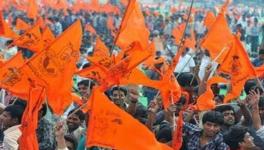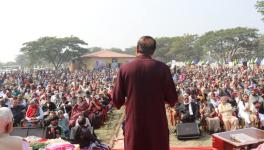Halfway Mark of Uttar Pradesh Poll: What Voters Signalled So Far
Representational use only.
The ongoing fourth phase of the Uttar Pradesh election on 23 February must be viewed in the context of the earlier three stages of these polls. So far, by most indications, the Samajwadi Party-led alliance has the edge over the Bharatiya Janata Party, which swept the 2017 Assembly election in the state. Political analysts have said that in the first two phases, a tsunami was blowing against the BJP.
Even journalistic accounts have found the BJP on the back foot. In 2017, the BJP had swept 49 of the 58 seats that went to the polls in the first phase. Voter’s perceptions about the party ruling Uttar Pradesh have shifted since then, or why else would Home Minister Amit Shah have tried, unsuccessfully, to woo Rashtriya Lok Dal (RLD) leader Jayant Chaudhary in the thick of this battle? Shah’s outreach was widely seen as a signal to the discontented Jats to desert the Samajwadi Party-led alliance with the RLD and return to the BJP fold.
If Jat-Muslim unity restored by the farmer movement jolted the BJP in the first phase, in the third phase, which took place in the aloo or potato-growing belt of Uttar Pradesh, the BJP left discouraged again. This phase included Samajwadi Party bastions where its base voters, the Yadavs—11% of the state population—are numerically concentrated.
In the third phase, the opposition alliance with the Mahan Dal came into play. This party has several backward social groups such as the Maurya, Shakya, Saini, and Khuswaha in its fold. This alliance demonstrates the Samajwadi Party’s ability to provide political representation to social groups beyond the Muslim-Yadav frame. Earlier, party chief Akhilesh Yadav had smartly inducted Swami Prasad Maurya, Dharam Singh Saini (who contested on the Samajwadi Party ticket in the second phase from district Saharanpur) and Dara Singh Chouhan. These three prominent leaders had recently exited the BJP, accusing it of making the social justice agenda of the Other Backward Classes of Uttar Pradesh subservient to its social engineering agenda.
They said the BJP, despite electoral victories in 2014, 2017 and 2019 through their support, sidelined the leaders and voters who belonged to the Other Backward Classes. By all accounts, the Samajwadi Party’s alliances performed reasonably successfully in the third phase, and this will impact subsequent stages as the election moves towards the eastern parts of the state.
In the last few phases, Akhilesh is likely to concentrate his appeals for votes to the non-Jatav Dalits, who make up roughly 15% of the Scheduled Caste population in Uttar Pradesh. His party has embraced the leading Dalit icon and constitutionalist BR Ambedkar, displaying his images on social media and in public meetings. The adoption of Ambedkar and the inclusion of his supporters in the party programmes are part of an attempt to broaden the social composition and image. Mandal politics has shifted perceptibly to a blend of Lohiaite and Ambedkarite ideas by mobilising the most backward among the backward classes to counter the aggressive Hindutva appeal of the BJP.
As the election campaign progressed, BJP leaders continuously upscaled their venomous Hindutva campaign by repeatedly targeting their opponents and isolating the state's Muslims. Despite the polarising narratives, it seems voters are not getting swayed. Even the BJP’s election manifesto is anchored on extremely divisive and communal narratives such as love jihad. The Prime Minister recently referred to the bicycle, the electoral symbol of the Samajwadi Party, to make a highly unacceptable disparaging remark that it is a vehicle used by terrorists to ferry explosives. However, there are some indications that this statement did not appeal to voters.
By ending the infighting and disarray that plagued the Samajwadi Party until 2019, Akhilesh has demonstrated he is the one who leads and unites the party and outfits oriented towards social justice. The presence and support of Mulayalam Singh, his father and party founder, indicated the resilience and cohesiveness of the party under him. It transmitted to the electorate that their disenchantment towards the ruling party would find a fitting response in the Samajwadi Party.
The contest in Uttar Pradesh is mainly bipolar, as voters seem to be picking sides between Akhilesh and Yogi Adityanath, the incumbent Chief Minister. The bipolar tone has allowed the Opposition to centre their campaigns around price rise, unemployment, widespread poverty, and the stray cattle menace that affects farmers of all castes and communities. Besides, the refusal of the BJP to conduct a caste census is agitating those backward sections which were promised an equitable share in progress.
The BJP and its leadership, instead of responding to pressing issues, has been trying to marginalise critics and discontents by invoking divisive narratives in violation of all established campaign norms. Stray cattle have become so grave a problem that each abandoned animal roaming in the fields and destroying crops could represent an anti-incumbency vote. The thoughtless cow protection policies adopted by the state government in complete disregard of the poor and farmers created this situation in the first place.
As the election crosses the halfway mark, the biggest lesson is that the party which gets the support of the OBCs will register its electoral victory. Noted political analyst Sanjay Kumar of the Centre for Studies of Developing Societies (CSDS) has said that the BJP is likely to lose 30-35% of its backward caste voters in this election compared with the last one. Therefore, the trends so far unmistakably show that apart from social coalitions, the party that raises the social and economic discontent of the people will get votes. This is why the third phase was crucial, for it affirmed the resilience of politics based on issues beyond the so-called Jat-Muslim regions.
The advantages of the “double-engine” government that Prime Minister Narendra Modi and Chief Minister Adityanath talk about does not sync with the lived reality of the middle classes and the poor. Massive unemployment, economic failures and consequent distress, not to mention the severe governance deficit, prove the futility of seeking a double-engine government. Many interpret such a government causes double the jeopardy, manifesting in the growing disaffection among people.
If the communal agenda of the BJP indeed fails to work, it would signal the hope that Hindutva is no longer a factor for winning elections. It would also signal that people want social and economic issues addressed by parties. It would augur well before the 2024 national election when the country confronts the communal forces that control the State apparatus again. Divisive communalism has reduced India to a partially-free land and electoral autocracy, but this is a downward slide that only the people have the power to control.
The author was Officer on Special Duty and Press Secretary to President of India KR Narayanan. The views are personal.
Get the latest reports & analysis with people's perspective on Protests, movements & deep analytical videos, discussions of the current affairs in your Telegram app. Subscribe to NewsClick's Telegram channel & get Real-Time updates on stories, as they get published on our website.
























